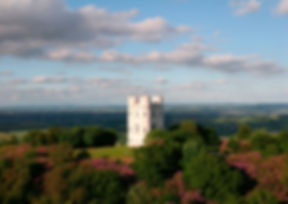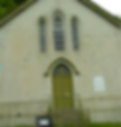
Devon Historic Buildings Trust
PORTFOLIO
The DHBT may help organisations come together to form a body or trust to purchase or lease and thus rescue an historic building. Additionally the DHBT is able to assist with the rescue of a building by way of sourcing viability studies, the preparation of conservation plans and funding streams.

Gazebo at Rosemore, Great Torrington
Originally the mid-18th century gazebo sat in the grounds of Palmer House in Great Torrington; a house with links to Sir Joshua Reynolds and Dr Samuel Johnson. The Grade ll Listed building was in a ruinous state and for some time there had been concerns that it should be saved.
Vision
Working with the RHS Garden Rosemore in Great Torrington, it was agreed that the gazebo should be reconstructed and positioned in the South Arboretum, making it available for the public to view. In 2001 the gazebo received the Civic Trust Awards.

The Role of DHBT – Buy and Sell
The DHBT may pull together a team to save a premises by taking out an option to purchase, to find a long term sustainable user and then restore or upgrade the building using available historic buildings grants.

Paignton Picture House, Paignton
In 2010 the DHBT worked with the National Trust to find a way forward to retain the recently closed Grade II* Listed 1914 cinema. Surveys, a conservation plan and a feasibility study were commissioned and the Trust worked with Torbay Borough Council, the Conservation Officer and English Heritage.
Vision
In 2015 a new trust, the Paignton Picture House Trust, was formed and the DHBT retain an interest in the building through a trustee sitting on both trusts.

The Role of DHBT – Act in an advisory capacity
The DHBT may help organisations come together to form a body or trust to purchase or lease and thus rescue an historic building. Additionally the DHBT is able to assist with the rescue of a building by way of sourcing viability studies, the preparation of conservation plans and funding streams.

Sanders, Lettaford
A fine example of a 17 th century Dartmoor longhouse which has remained virtually unaltered. The Grade II* house was purchased by the DHBT for restoration.
Vision
The cost of the restoration was beyond the means of the Trust at that time, and whilst still in a dilapidated state it was sold to the Landmark Trust who undertook its restoration

The Role of DHBT – Buy and preserve
The DHBT may buy and preserve a building until a sustainable long term solution is found. The DHBT may sell the property to secure a new future within the local community.

Morwellham Chapel, Near Tavistock
An untouched example of a Methodist chapel in a mining area. The building was left untended and was rescued by the DHBT and West Devon Borough Council.
Vision
It is now owned by the DHBT and leased to the Cornwall and West Devon Mining Landscape World Heritage Site.

The Role of DHBT – Buy, Lease and Retain
The DHBT is able to lease a property, renovate it and retain it for the future. Any profits from business use or rent are used to maintain the property.

38 Holloway Street, Exeter
Hooe Barn has had a chequered history and is the only remaining building of the former Hooe Barton Farm which was demolished in the 1960s. The barn, one of only four remaining 16th century threshing barns in the country, was in a poor state of repair.
Vision
In 2002 the DHBT worked with the local community to prepare a condition report and a feasibility study to look at a future community use. To date the barn remains unchanged and unused due to issues with Plymouth City Council and the owners of the premises.

The Role of DHBT – Buy and Sell
The DHBT is a revolving buildings trust that may buy, renovate and sell for a profit. All profits are then used for subsequent projects.
Vision
In 2002 the DHBT worked with the local community to prepare a condition report and a feasibility study to look at a future community use. To date the barn remains unchanged and unused due to issues with Plymouth City Council and the owners of the premises.


Hooe Barn, Plymouth
Hooe Barn has had a chequered history and is the only remaining building of the former Hooe Barton Farm which was demolished in the 1960s. The barn, one of only four remaining 16th century threshing barns in the country, was in a poor state of repair.
The Role of DHBT – Act in an advisory capacity
The DHBT may help organisations come together to form a body or trust to purchase or lease and thus rescue an historic building. Additionally the DHBT is able to assist with the rescue of a building by way of sourcing viability studies, the preparation of conservation plans and funding streams.

Haldon Belvedere
Following local concern the DHBT was approached by the Stringer Lawrence Memorial Trust which was formed to safeguard the Belvedere’s future, to assist them obtain the necessary funding to restore the near derelict 18th century Grade II* castle.
Vision
Funds were secured through extensive local fund raising and with financial support from English Heritage; Teignbridge District Council and Devon County Council. On completion of the restoration in 1994 the DHBT took on the lease Keeping the building open to the public and all income is used to maintain the castle and grounds. During the summer of 2016 an extensive redecoration of the exterior is underway with assistance from Viridor Credits.

The Role of DHBT – Buy, lease and retain
The DHBT is able to lease a property, renovate it and retain it for the future. Any profits from business use or rent are used to maintain the property.

Cornhill, Ottery St Mary
ocated in the conservation area in Ottery St Mary the two 18th century Listed Buildings were unoccupied and in a dilapidated state.
Vision
The buildings were redeveloped through a formal tender process as retail and apartments. The properties were sold on the open market, and the net profit returned to the revolving capital fund.

The Role of DHBT – Buy, lease and retain
The DHBT is able to lease a property, renovate it and retain it for the future. Any profits from business use or rent are used to maintain the property.

Guildhall Police Station, Tavistock
Following a change in the policy of the Devon & Cornwall Police the Grade II* 19th century Police Station and Magistrates Court, which sits on the remains of the medieval Tavistock Abbey, became surplus to their needs.
Vision
The DHBT purchased the buildings, and during the following three years the Trust maintained the buildings to keep them weather tight. The Trust also put in hand the necessary support work to enable a future owner to move forward the regeneration of the buildings.
Suitable sustainable long term purchasers were sought, and the buildings are now in the ownership of Tavistock Town Council who seek Grant funding to convert the buildings into a World Heritage Interpretation Centre.

The Role of DHBT – Buy and preserve
The DHBT may buy and preserve a building until a sustainable long term solution is found. The DHBT may sell the property to secure a new future within the local community.

Cricklepit Mill
The mill which is of unknown period but probably dates from the 15 th century had been empty since the 1950s. It was in a dilapidated and dangerous condition and there were demands for its demolition.
Vision
The Trust were able to take over the building and completed the first and most major part of its restoration. The Devon Wildlife Trust took over the premises and completed the final stage of its restoration. This was the second largest project that The Trust had undertaken and it received the 2003 Michelmores Heritage Project of the Year Award.
